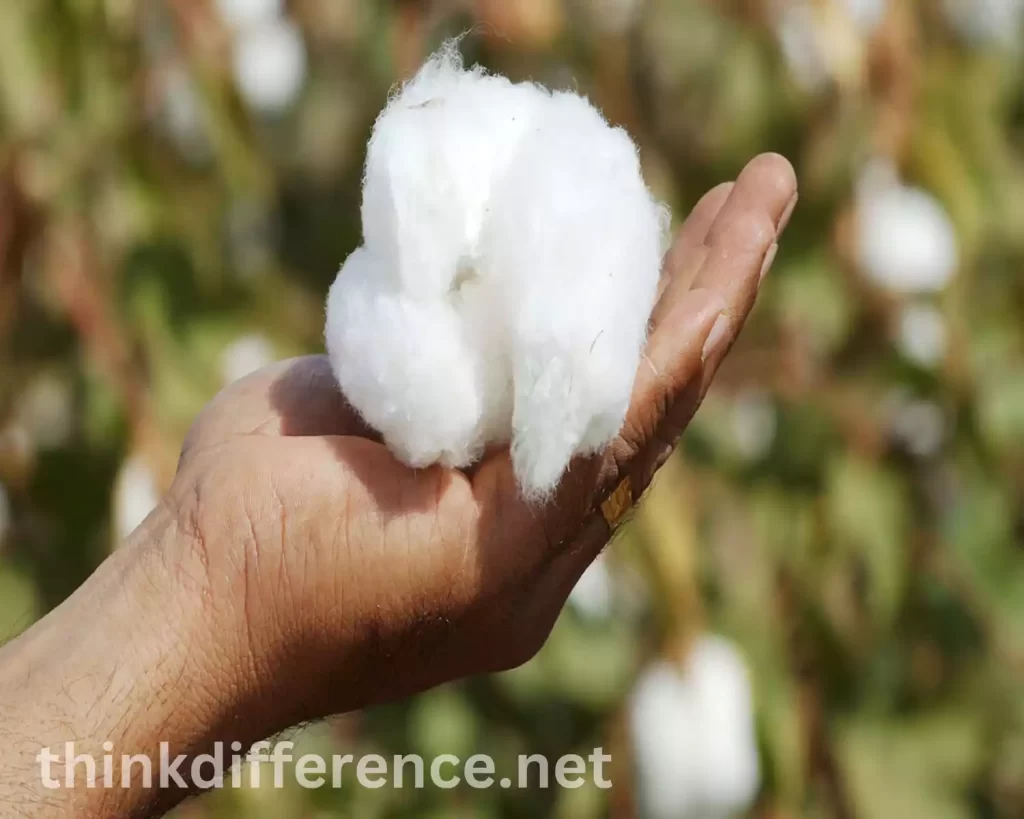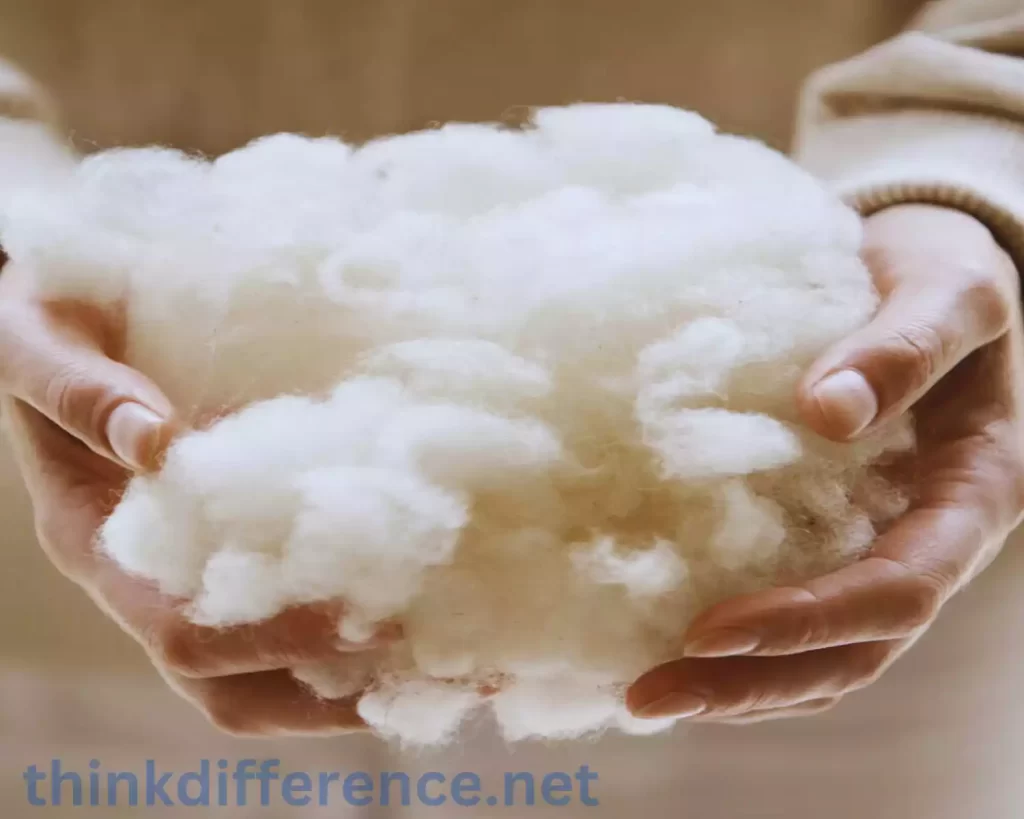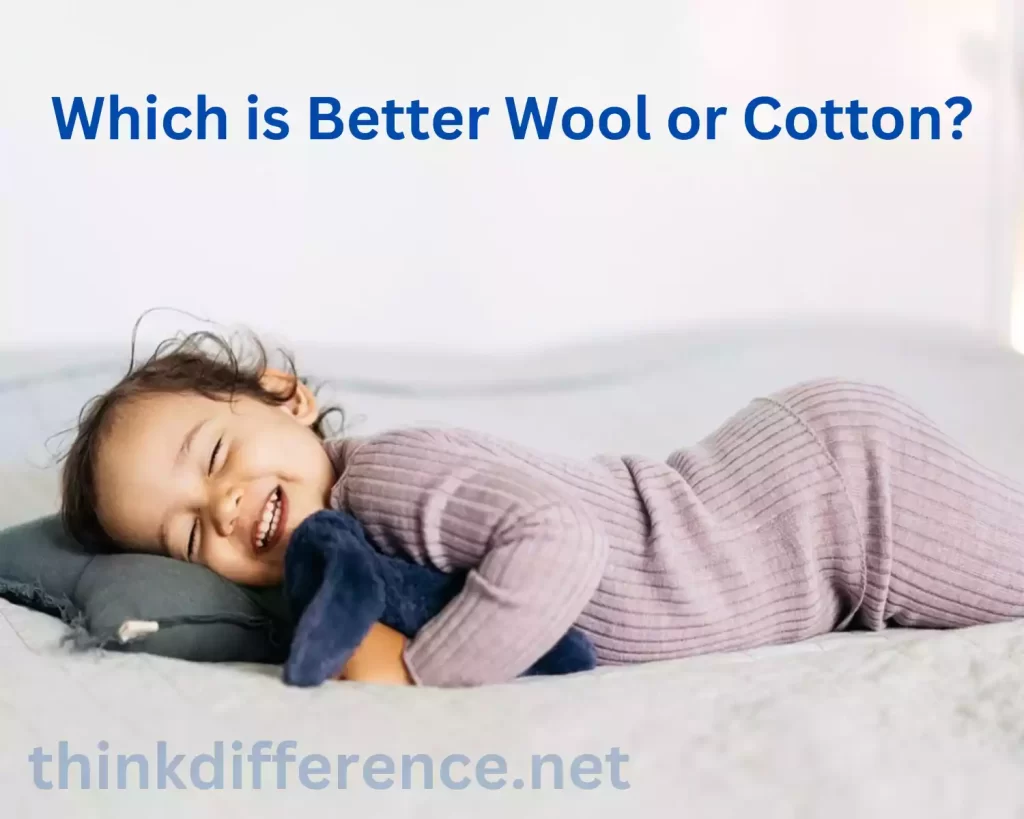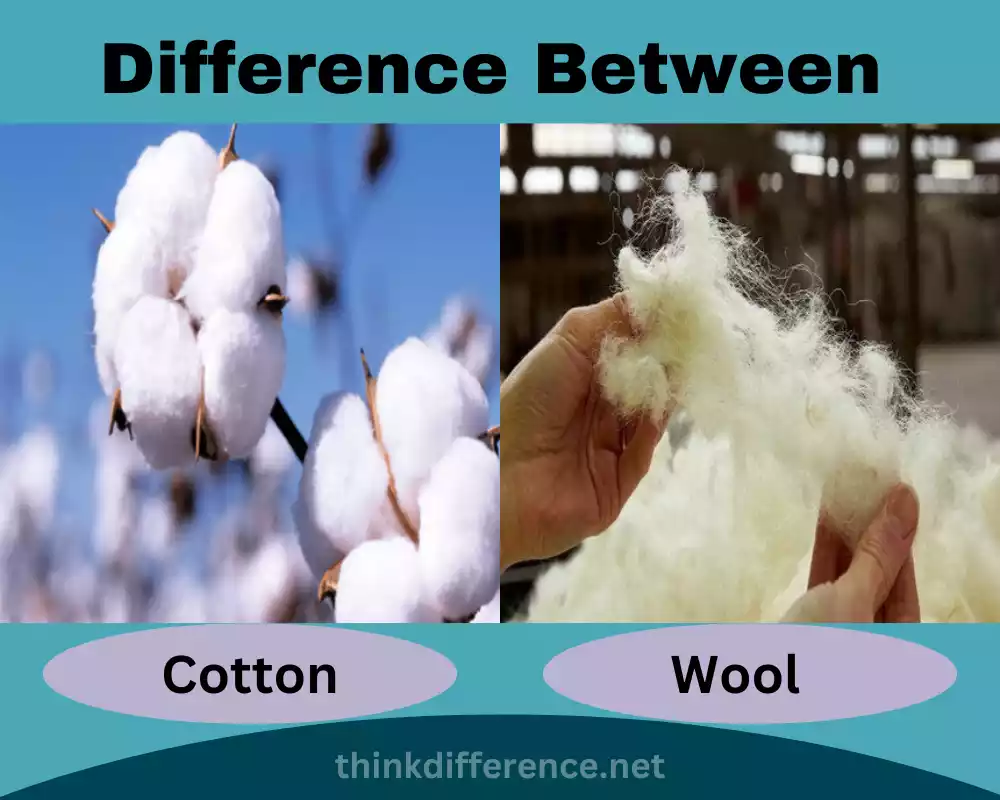Cotton and Wool fibers are natural textiles sourced from plants and animals alike, such as cotton seeds with fluffy fibrous coverings. Wool comes from sheep fleece or other animals like goats. These natural resources have unique properties which make them invaluable resources in many industries.
What is Cotton?
Cotton fiber originates from the fluffy parts around cotton seeds in plants, helping them travel greater distances when exposed to wind. Since ancient civilizations, humans have used this natural fiber for clothing production.

Cotton harvesting takes place globally to provide natural fibers used for textile fabrics. Once harvested it must first be combed out so as to remove seeds before being ready for spinning into threads suitable for knitting and weaving fabrics.
Characteristics of Cotton
Cotton is a widely used natural fiber known for its softness, breathability, and versatility. Here are some key characteristics of cotton:
- Appearance and Texture: Cotton fibers have a smooth, soft, and fluffy texture. The fabric made from cotton has a natural luster and a pleasing aesthetic appeal.
- Breathability: Cotton is highly breathable, allowing air to circulate through the fabric. This makes it comfortable to wear in warm and humid climates as it helps to keep the body cool by allowing sweat to evaporate quickly.
- Moisture Absorption: Cotton has excellent moisture absorption properties. It can absorb moisture up to 27 times its own weight without feeling damp, making it ideal for sweat-wicking and keeping the skin dry.
- Softness and Comfort: Cotton is known for its soft and comfortable feel against the skin. Product is suitable for people with sensitive and allergic skin conditions.
- Durability and Strength: Cotton fibers are relatively strong and durable, especially when compared to other natural fibers. They can withstand regular wear and tear and are less prone to tearing or breaking.
- Easy to Care for: Cotton is easy to care for and can withstand frequent washing and drying without losing its shape or quality. It can be machine-washed, and most cotton fabrics are resistant to wrinkling.
- Versatility: Cotton fibre can be utilized in numerous products including clothing, bedding and towels. It can be woven or knitted into different fabric weights and textures, allowing for various applications.
- Hypoallergenic: Cotton fabrics tend to be hypoallergenic, meaning that they’re unlikely to cause skin irritations reactions in people. Dyes and chemicals used to treat cotton fabrics could potentially irritate certain individuals’ sensibilities.
- Sustainability: Cotton farming can be done sustainably without resorting to chemical pesticides and fertilizers, creating an eco-friendly cotton crop. Organic cotton farming practices promote environmental sustainability and minimize the impact on ecosystems.
- Dyeability: Cotton readily absorbs dyes, resulting in vibrant and long-lasting colors. It can be easily dyed in a wide range of shades and hues, offering creative possibilities for designers and consumers.
Cotton fabric offers many advantages over synthetic alternatives, including comfort, versatility and natural properties that enhance its use as everyday apparel or home furnishing. Cotton can also help regulate body temperature through perspiration – something synthetic materials cannot do effectively. It can even help lower allergy-inducing emissions.
What is Wool?
Wool is produced from the woolen coat on sheep, known as fleece. This material can easily be transformed into threads for clothing such as jackets, trousers, socks and hats made out of woolen fabric woven or knitted from yarn harvested by animals such as goats.

Wool not only keeps wearers warm and comfortable during wear, but it has excellent moisture-wicking capabilities; thus making it preferable over other fabrics as sweat can quickly be absorbed through its fibers and keeps you dry! It can be dyed into beautiful designs or patterns created out of color combinations!
Shearers take advantage of sheep shearing to harvest an entire fleece for washing in order to eliminate impurities and create the optimal blend for dyeing purposes by mixing various kinds of wools together.
Due to wool’s elastic qualities, fibers from it can then be spun into long fibers which are knitted before chemically shrinking for continued wearability after each washing cycle. Many are unaware that both goat and sheep hairs can be used as material for crafting clothing (known respectively as mohair and wool).
Characteristics of Wool
Wool is a natural fiber known for its warmth, insulation, and unique properties. Here are some key characteristics of wool:
- Appearance and Texture: Wool fibers have a crimped or wavy structure, giving them a distinctive texture and appearance. The fabric made from wool has a natural loftiness and can have a soft and luxurious feel.
- Insulation and Warmth: Wool is an excellent insulator, providing warmth in cold weather. The crimped structure of wool fibers traps air pockets, which helps to retain body heat and create a thermal barrier.
- Moisture-wicking Properties: Wool has natural moisture-wicking properties, meaning it can absorb moisture vapor from the body and release it into the air. This helps to regulate body temperature and keep the wearer dry and comfortable.
- Softness and Comfort: Wool can vary in softness depending on the type of wool and the processing techniques used. Fine wool, such as merino wool, is known for its soft and smooth texture, making it comfortable to wear against the skin.
- Durability and Resilience: Wool fibers are naturally strong and elastic, making them resistant to breaking or tearing. Wool garments and textiles are known for their durability and ability to retain their shape even with frequent use.
- Odor Resistance: Wool has natural antimicrobial properties that inhibit the growth of odor-causing bacteria. This makes wool garments less prone to developing unpleasant odors, even after prolonged wear.
- Fire Resistance: Wool is naturally flame-resistant. It has a higher ignition threshold and is less likely to melt or stick to the skin when exposed to flames. This makes it a safer choice compared to many synthetic fibers.
- All-Weather Performance: Wool is a versatile fiber that can provide insulation and warmth in cold climates while also offering breathability in warmer conditions. It helps to regulate body temperature, making it suitable for various weather conditions.
- Water Repellency: Wool fibers have a natural outer layer that repels water, making wool garments resistant to light rain or moisture. Prolonged exposure to heavy rain can cause wool to become saturated.
- Sustainability: Wool is a renewable and biodegradable fiber. Product is made of sheep, goats and other animal sources that have been responsibly farmed to meet sustainability and environmental targets.
- Natural UV Protection: Wool is an effective natural solution to UV radiation exposure and sunburn risk reduction, acting like an ultraviolet (UV) barrier between you and harmful sun rays. By absorbing and scattering UV rays, wool absorbs UV radiation while also decreasing skin damage risk and sunburn risk.
- Sound and Vibration Absorption: Wool is an effective sound and vibration absorber that can reduce noise to create an environment more peaceful and quiet.
Wool is an adaptable fabric with many uses in clothing, blankets and carpeting applications. Thanks to its natural insulation properties and resilience it remains popular choice when choosing insulation material.
Differences between Cotton and Wool
Wool and cotton are two distinct natural fibers with unique characteristics.
Here are some key differences between wool and cotton:
- Source: Wool is produced from animal fur or fleece such as that found on sheep, goats (such as cashmere and mohair) llamas or alpacas. Cotton, on the other hand, comes from the seed fibers of the cotton plant.
- Fiber Structure: Wool fibers have a crimped or wavy structure, which gives them elasticity and bulkiness. Cotton fibers, in contrast, are straight and cylindrical, lacking the natural crimp of wool.
- Insulation and Warmth: Wool is an excellent insulator and provides superior warmth due to the air pockets trapped within its crimped structure. Cotton, while breathable, does not have the same level of insulation as wool and is more suitable for warm or moderate temperatures.
- Moisture Absorption and Breathability: Wool is an effective material at drawing moisture away from your body and discharging it into the atmosphere, keeping you dry throughout your wearable experience. Cotton also has good moisture absorption but tends to retain moisture, making it less effective in wicking away sweat.
- Softness and Texture: Wool fibers are known for their softness and natural resilience. The texture of wool can vary depending on the type of wool and processing. Cotton fibers are typically smooth and have a softer feel against the skin.
- Allergenic Potential: Wool, due to its complex structure and protein composition, can cause sensitivity or allergies in some individuals, resulting in itchiness or skin irritation. Cotton fibers are widely considered hypoallergenic, which makes them less likely than other fabrics to trigger allergies in people.
- Care and Maintenance: Wool requires more specific care compared to cotton. It is often recommended to hand wash or dry clean wool garments to maintain their shape and quality. Cotton is typically machine-washable and easy to care for.
- Durability: Wool fibers are naturally strong and resilient, which contributes to their durability. Cotton fibers, while also durable, are generally not as strong as wool and can be prone to wear and tear over time.
- Applications: Wool is commonly used in winter clothing, cold-weather accessories, and home textiles like blankets and carpets. Cotton is widely used in everyday clothing, including t-shirts, jeans, dresses, and various home textile products bed linens, towels, and curtains.
- Environmental Impact: Wool production has a lower environmental impact in terms of water usage and synthetic chemical usage compared to conventional cotton production. Cotton farming, especially when done conventionally, requires significant water resources and often involves the use of pesticides and fertilizers.
These differences highlight the unique properties and applications of wool and cotton, making each fiber suitable for specific uses based on factors such as climate, comfort, and desired characteristics.
Environmental Impact
The environmental impact of Cotton and Wool production can vary based on various factors, including farming practices, processing methods, and the lifecycle of the products.
Here are some key considerations regarding the environmental impact of cotton and wool:
Cotton:
- Water Usage: Cotton farming requires significant amounts of water, particularly in regions with arid or semi-arid climates. Conventional cotton cultivation can contribute to water scarcity and strain water resources in areas where water is already limited.
- Pesticides and Chemicals: Cotton farming is often performed using synthetic pesticides and herbicides that pose significant threats to soil quality, water systems and biodiversity – as well as potentially being health risks to both farmers and members of their surrounding community.
- Genetic Modification: Genetically modified cotton, known as GM cotton is widely grown in some regions. While GM cotton can improve yields and reduce pesticide usage, it raises concerns related to the long-term environmental impact and potential gene flow to wild relatives.
- Soil Degradation: Cotton cultivation without proper soil management practices can result in soil degradation – including erosion, loss of organic matter and reduced fertility – with serious negative ramifications on agricultural systems’ sustainability.
- Organic and Sustainable Practices: Organic cotton farming avoids synthetic pesticides and genetically modified organisms, promotes biodiversity, and promotes soil health. Organic certification programs and sustainable practices aim to reduce the environmental impact of cotton production.
Wool:
- Grazing and Land Management: Wool production relies on grazing animals such as sheep, which require land for pasture. Unscrupulous land management and overgrazing can result in soil erosion and desertification. Sustainable grazing practices and proper land stewardship are essential to minimize these impacts.
- Energy and Water Usage: Processing wool involves various stages, including shearing, washing, carding, spinning, and dyeing. Environmental impacts at each step in these processes depend on how efficient and eco-friendly their technologies are used.
- Chemical Dyes: Some wool products may undergo dyeing processes that involve the use of synthetic dyes and chemicals. The discharge of untreated dye wastewater can pollute water bodies and harm aquatic life. Eco-friendly dyeing practices and the use of natural dyes can help reduce the environmental impact.
- Animal Welfare: The well-being of sheep and other wool-producing animals is an important consideration. Ethical and responsible farming practices, such as providing proper living conditions and ensuring animal health, are crucial for sustainable wool production.
- Biodegradability: Wool is an eco-friendly fiber which breaks down without polluting the environment at its end of life cycle.
To mitigate the environmental impact of cotton and wool production, various initiatives have been undertaken. These include organic and sustainable farming practices, water conservation efforts, reduced chemical usage, improved supply chain transparency, and certifications for environmentally friendly production methods.
Consumers can also play a role by choosing products made from organic or sustainably sourced cotton and wool, and by supporting brands that prioritize environmental responsibility.
Which is Better, Wool or Cotton?
Determining which is better, wool or cotton, depends on various factors and personal preferences.

Here are some considerations to help you make a decision:
- Climate and Temperature: Wool is better suited for colder climates due to its superior insulation and warmth. It helps retain body heat and keeps you cozy in colder weather. Cotton, on the other hand, is more breathable and suitable for warm or moderate temperatures, allowing air circulation and keeping you cool.
- Comfort and Feel: Wool offers a soft and luxurious feel, particularly when it comes to finer types like merino wool. It has a natural resilience and provides a cozy sensation. Cotton offers comfort and breathability with its smooth, soft surface.
- Moisture Management: Wool fabric excels at drawing moisture away from your skin to keep you comfortable and dry. This ensures a more pleasant wearing experience overall. Cotton also has good moisture absorption, but it tends to retain moisture, potentially feeling damp.
- Durability: Wool fibers are naturally strong and durable, making them more resistant to wear and tear compared to cotton. Wool garments often have a longer lifespan and maintain their shape and quality over time. Cotton is also durable but may show signs of wear more easily, particularly with frequent washing.
- Allergies and Sensitivities: Wool can potentially cause allergies or skin irritation in some individuals due to its complex structure and protein composition. Cotton is generally considered hypoallergenic and less likely to cause sensitivities or skin reactions.
- Care and Maintenance: Wool requires specific care, often involving handwashing or dry cleaning, to maintain its shape and quality. Cotton fibers are machine-washable and easy to care for, providing simple maintenance tasks for quick results.
- Sustainability: Produced using eco-friendly farming practices, its environmental footprint is lower than cotton production methods. Organic and eco-friendly options exist that promote environmentally conscious choices.
Wool or cotton? That depends entirely upon your individual circumstances, preferences and climate conditions. Wool excels in colder temperatures and provides exceptional insulation and warmth.
Cotton, on the other hand, offers breathability, softness, and comfort in warm or moderate climates. Both fibers have their own unique qualities and can be suitable for different applications and personal preferences.
Conclusion
Cotton and Wool are two distinct natural fibers with their own set of characteristics and applications. Wool, sourced from animal hair, offers excellent insulation, warmth, moisture-wicking properties, and durability. It is commonly used in cold-weather clothing, home textiles, and insulation materials.
Cotton, derived from the seed fibers of the cotton plant, is known for its softness, breathability, and versatility. It is widely used in everyday clothing, home textiles, and various industrial applications.



